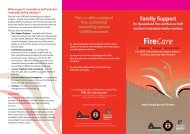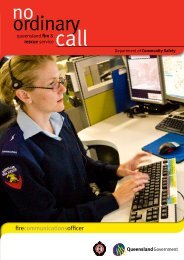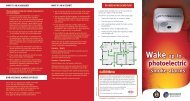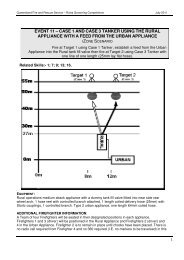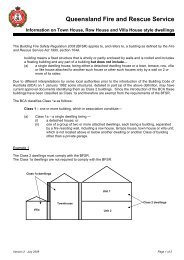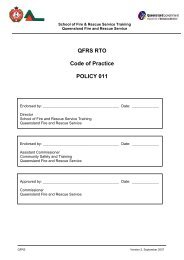Photoelectric Smoke Alarms - Queensland Fire and Rescue Service ...
Photoelectric Smoke Alarms - Queensland Fire and Rescue Service ...
Photoelectric Smoke Alarms - Queensland Fire and Rescue Service ...
Create successful ePaper yourself
Turn your PDF publications into a flip-book with our unique Google optimized e-Paper software.
Information for retail <strong>and</strong> industry.<br />
<strong>Photoelectric</strong><br />
<strong>Smoke</strong> <strong>Alarms</strong><br />
Selection, installation <strong>and</strong> maintenance<br />
This booklet is designed to assist fire-related<br />
industries <strong>and</strong> retailers with information <strong>and</strong><br />
advice for their customers.<br />
For more information, phone 1300 369 003 (for the cost of<br />
a local call) or go to the <strong>Queensl<strong>and</strong></strong> <strong>Fire</strong> <strong>and</strong> <strong>Rescue</strong> <strong>Service</strong><br />
website at www.fire.qld.gov.au
Contents<br />
Introduction 3<br />
Facts 4<br />
<strong>Smoke</strong> kills 6<br />
Types of smoke alarms 7<br />
<strong>Photoelectric</strong> smoke alarms<br />
(recommended for use in homes) 7<br />
Ionisation smoke alarms 8<br />
Classes of smoke alarms 9<br />
A 240 volt (hardwired) smoke alarm 9<br />
A 10-year battery smoke alarm 10<br />
A 9 volt smoke alarm 10<br />
Other smoke alarm options 11<br />
Other options 11<br />
<strong>Smoke</strong> alarms for deaf <strong>and</strong> hard of hearing people 11<br />
Choosing a smoke alarm 12<br />
Maintaining a smoke alarm 13<br />
How many smoke alarms are required? 14<br />
Legally required minimum 14<br />
<strong>Queensl<strong>and</strong></strong> <strong>Fire</strong> <strong>and</strong> <strong>Rescue</strong> <strong>Service</strong> additional recommendations 14<br />
Ideal smoke alarm locations 15<br />
Seller, l<strong>and</strong>lord <strong>and</strong> tenant responsibilities 16<br />
Sellers 16<br />
L<strong>and</strong>lords 16<br />
Tenants 17<br />
Disposal of smoke alarms 17<br />
Other smoke alarm facts 18<br />
What is the difference between smoke alarms <strong>and</strong> smoke detectors? 19<br />
Safehome: a free <strong>Queensl<strong>and</strong></strong> <strong>Fire</strong> <strong>and</strong> <strong>Rescue</strong> <strong>Service</strong> fire-safety check for<br />
<strong>Queensl<strong>and</strong></strong>ers 20<br />
For more information,<br />
telephone 1300 369<br />
003 (for the cost of a<br />
local call) or go to the<br />
<strong>Queensl<strong>and</strong></strong> <strong>Fire</strong> <strong>and</strong><br />
<strong>Rescue</strong> <strong>Service</strong> website<br />
at www.fire.qld.gov.au<br />
Introduction<br />
Legislation makes it compulsory for all homes in<br />
<strong>Queensl<strong>and</strong></strong> to have smoke alarms installed.<br />
The <strong>Fire</strong> <strong>and</strong> <strong>Rescue</strong> <strong>Service</strong> Act 1990 (sections 104RB –<br />
104 RJ):<br />
<br />
<br />
Requires homes built before July 1997 to have smoke<br />
alarms installed, which:<br />
• Comply with Australian St<strong>and</strong>ard AS 3786<br />
• Are correctly located (see page 15)<br />
Specifies the responsibilities of l<strong>and</strong>lords <strong>and</strong> tenants<br />
for the installation <strong>and</strong> maintenance of smoke alarms<br />
(see pages 16 <strong>and</strong> 13).<br />
This legislation complements other legislation<br />
which requires that all new homes, <strong>and</strong> substantial<br />
renovations to existing homes, have hard-wired smoke<br />
alarms installed.<br />
The level of protection against fire increases with the<br />
quality, type <strong>and</strong> number of smoke alarms installed<br />
<strong>and</strong> whether they are free st<strong>and</strong>ing smoke alarms or<br />
interconnected smoke alarms.<br />
This booklet will assist you to give reliable information<br />
to customers to help them choose smoke alarms<br />
wisely.<br />
<strong>Queensl<strong>and</strong></strong> <strong>Fire</strong> <strong>and</strong> <strong>Rescue</strong><br />
<strong>Service</strong> position is that all residential<br />
accomodation be fitted with<br />
photoelectric smoke alarms.<br />
3
Facts<br />
‘<strong>Smoke</strong> alarms saved us.’<br />
(Toowoomba Chronicle 28/11/09)<br />
<br />
<br />
<br />
<br />
<strong>Photoelectric</strong> smoke alarms are early fire detection devices that save lives.<br />
The risk of death from a fire is more than twice as high in homes without<br />
smoke alarms when compared to homes with smoke alarms.<br />
The vast majority of <strong>Queensl<strong>and</strong></strong> homes have smoke alarms. However, people<br />
still die because their smoke alarms have not been looked after <strong>and</strong> batteries<br />
aren’t working or have been removed.<br />
Each year there are more than 1,250 residential fires in <strong>Queensl<strong>and</strong></strong>.<br />
A family of four escaped unscathed as a blaze raged through their weatherboard<br />
home in the north Brisbane suburb of Nundah this morning...The family was<br />
alerted to the fire by smoke alarms…(The Courier Mail 01/12/08)<br />
Burning c<strong>and</strong>les have almost cost a ... woman her life – <strong>and</strong> her home. The<br />
woman waswoken by a smoke alarm ... (The Courier Mail 30/10/09)<br />
‘I’ve been to jobs … where someone has died <strong>and</strong> you think to yourself, ‘if<br />
only they had a smoke alarm’. (<strong>Fire</strong> fighter, The Townsville Bulletin 21/11/09)<br />
(A) family of seven was forced to flee their home after clothes drying<br />
around a heater in the living room caught alight…Within a few minutes<br />
of the alarm sounding, the whole house was in flames .. the single-storey<br />
brick veneer house was damaged so badly it (will) most likely have<br />
to be demolished… the family owed their lives to the smoke alarm.’<br />
(The Courier Mail 22/07/08)<br />
A Sunshine Coast mother said a smoke alarm helped save her son’s life when<br />
their Mooloolaba home was destroyed by fire last night…Ms P.. said checking<br />
smoke alarms were working correctly was essential … it helped save her<br />
son’s life. (The Courier Mail 29/11/08)<br />
A house at Howard, 30 km north of Maryborough, was destroyed by fire<br />
about 1 am this morning. The home’s occupants were awoken by their smoke<br />
alarms <strong>and</strong> escaped the house with no injuries. (The Courier Mail 30/10/09)<br />
Four fires, five days...in a devastating week (on the) Sunshine Coast…<br />
‘The smoke alarm alerted her .. – it was a damn good thing’<br />
(Husb<strong>and</strong>, Sunshine Coast Daily 02/12/09)<br />
Only working smoke<br />
alarms save lives.<br />
The house was completely destroyed in the fire which early investigations<br />
indicate was started from a c<strong>and</strong>le ... The owner told me that by the time she<br />
gathered up the kids <strong>and</strong> came out the front door ... the house was totally up<br />
in flames. It just goes to show how important it is to habe smoke detectors.<br />
(<strong>Queensl<strong>and</strong></strong> Times 27/11/09)<br />
The toaster caught fire <strong>and</strong> spread through the kitchen… The<br />
entire front of the house was destroyed .. there was also minor<br />
damage to the neighbouring property which shares a common<br />
wall. There were no working smoke alarms in the house.<br />
(The Courier Mail 16/10/08)<br />
4 5
<strong>Smoke</strong> kills<br />
Toxic smoke <strong>and</strong> fumes kill. In a house<br />
fire, flames cause structural damage<br />
<strong>and</strong> smoke is the main danger to people.<br />
<strong>Smoke</strong> poisoning causes the majority of<br />
fire-related deaths.<br />
Homes contain many materials, such as<br />
foam, wood, wool, nylon <strong>and</strong> plastics.<br />
When burning, these materials release<br />
heavy smoke <strong>and</strong> toxic fumes such as<br />
carbon monoxide <strong>and</strong> cyanide gas.<br />
These materials can smoulder for a long<br />
time, emitting a lot of smoke <strong>and</strong> fumes<br />
before they burst into flames.<br />
Research indicates that house fires today<br />
burn faster <strong>and</strong> kills quicker than house<br />
fires a few decades ago.<br />
Research in the 1970s showed a safe<br />
escape time of 17 minutes. This has now<br />
decreased to an escape time of just three<br />
minutes. The significant drop in escape<br />
time is due to the contents of modern<br />
homes (such as furnishings) which<br />
smoulder, releasing toxic gases, <strong>and</strong><br />
burn faster <strong>and</strong> more intently.<br />
If you are asleep when a fire starts,<br />
you could suffer from smoke inhalation<br />
before you wake up. The combination of<br />
toxic smoke <strong>and</strong> reduced oxygen in the<br />
air can make waking more difficult. For<br />
these reasons, it is important to have<br />
a smoke alarm that detects smoke <strong>and</strong><br />
alerts you to the danger.<br />
The <strong>Queensl<strong>and</strong></strong> <strong>Fire</strong> <strong>and</strong> <strong>Rescue</strong> <strong>Service</strong><br />
(QFRS) recommends photoelectric smoke<br />
alarms (see pages 7-10, 12 <strong>and</strong> 18).<br />
Types of smoke alarms<br />
There are two main types of smoke alarms - photoelectric <strong>and</strong> ionisation.<br />
<strong>Photoelectric</strong> smoke alarms<br />
(recommended for use in homes)<br />
<strong>Photoelectric</strong> is a type of smoke alarm, not a br<strong>and</strong>.<br />
<strong>Photoelectric</strong> smoke alarms ‘see’ smoke <strong>and</strong> detect visible particles of combustion<br />
(e.g. smouldering cigarette smoke).<br />
<strong>Photoelectric</strong> smoke alarms respond to a wide range of fires <strong>and</strong> are particularly<br />
responsive to smouldering fires <strong>and</strong> dense smoke such as that released by foam<br />
filled furnishings or overheated PVC wiring.<br />
Studies show that photoelectric alarms typically respond to smouldering fires,<br />
when the amount of smoke is fairly small <strong>and</strong> escape is relatively easy.<br />
Protection from fires increases with the quality <strong>and</strong> type of smoke alarms installed.<br />
Research shows that photoelectric smoke alarms are generally more effective than<br />
other smoke alarms across a wider range of fires experienced in homes.<br />
<strong>Photoelectric</strong> smoke alarms are recommended by the <strong>Queensl<strong>and</strong></strong> <strong>Fire</strong> <strong>and</strong> <strong>Rescue</strong><br />
<strong>Service</strong> for use in homes.<br />
Advantages<br />
<strong>Fire</strong> fighters pulled an unconscious man from his burning unit …The fire<br />
burned a bedroom <strong>and</strong> a section of the roof <strong>and</strong> caused heat <strong>and</strong> smoke<br />
damage to the remainder of the unit… There were no working smoke alarms<br />
in the unit. (The Courier Mail 06/05/09)<br />
<br />
<br />
<br />
<br />
Respond well to smouldering fires <strong>and</strong> dense smoke.<br />
Less prone to cooking nuisance alarms.<br />
Do not contain radioactive material.<br />
Suitable for general use.<br />
A unit at Gympie was engulfed in smoke after oil residue on a stove<br />
smoked up about 2 am. The emergency services spokeswoman said there<br />
was no fire <strong>and</strong> the occupants were also woken by their smoke alarms.<br />
One person was taken to Gympie General Hospital with smoke inhalation.<br />
(Media <strong>and</strong> Corporate Communications, Department of Emergency <strong>Service</strong>s 30/10/08)<br />
Disadvantages<br />
<br />
Prone to nuisance alarms from dust <strong>and</strong> insects. (All smoke alarms should be<br />
vacuumed or cleaned with a brush once a month to prevent this).<br />
6 7
Ionisation smoke alarms<br />
Ionisation smoke alarms take longer to respond to smouldering fires than<br />
photoelectric smoke alarms. This longer period of response results in lower<br />
visibility from smoke which makes escape more difficult.<br />
Ionisation smoke alarms are identified by the radiation symbol.<br />
Classes of smoke alarms<br />
There are three classes of photoelectric smoke alarms, which are classed according<br />
to the type of power supply.<br />
A 240 volt (hardwired) smoke alarm is connected to<br />
the home’s electrical system <strong>and</strong> has battery back-up power supply such as a longlife<br />
lithium or 9 volt short-term battery. 240 volt (hardwired) smoke alarms are<br />
available as photoelectric <strong>and</strong> ionisation alarms.<br />
If you have an ionisation smoke alarm installed, QFRS recommends that you:<br />
<br />
<br />
Supplement that existing alarm with a photoelectric smoke alarm, particularly<br />
between the sleeping <strong>and</strong> living areas <strong>and</strong> between the sleeping areas <strong>and</strong><br />
exits from your home (such as hallways).<br />
Replace your ionisation smoke alarm with a photoelectric smoke alarm before<br />
the alarm’s use-by-date.<br />
Disadvantages<br />
<br />
<br />
<br />
<strong>Photoelectric</strong> smoke alarms do not have radiation symbols on them.<br />
Prone to nuisance alarms due to cooking.<br />
May be slow to respond to slow smouldering fires.<br />
Contain small amounts of radioactive material.<br />
Advantages<br />
8 9<br />
<br />
<br />
<br />
<br />
<br />
<br />
<br />
<br />
More reliable than battery operated<br />
smoke alarms.<br />
Early warning – occupants alerted in<br />
the shortest possible time.<br />
Battery backup used if the AC power fails.<br />
Models can be interconnected – this sounds alarms in all connected units<br />
simultaneously.<br />
May come with a long-life lithium battery which is built-in <strong>and</strong> tamper proof.<br />
Power-on indicator.<br />
Some models have a hush button to stop nuisance alarms.<br />
Test button to check that the alarm is operating correctly.<br />
<br />
Tested by Scientific <strong>Service</strong>s laboratories (SSL) to comply with AS 3786.<br />
<br />
Some may be purchased with a rechargeable battery, which is nonreplaceable.<br />
These alarms must be installed by a<br />
qualified electrician.<br />
The 240 volt photoelectric smoke<br />
alarm is highly recommended by<br />
the <strong>Queensl<strong>and</strong></strong> <strong>Fire</strong> <strong>and</strong> <strong>Rescue</strong><br />
<strong>Service</strong> for all homes.<br />
<strong>Queensl<strong>and</strong></strong> law specifies that<br />
hardwired smoke alarms are<br />
required to be installed in all<br />
properties built since 1 July 1997<br />
<strong>and</strong> properties significantly<br />
renovated since that date (i.e.<br />
renovations exceeding 50 per<br />
cent of the original building,<br />
measured over the roof <strong>and</strong> the<br />
external walls).
A 10-year battery smoke alarm st<strong>and</strong>s alone <strong>and</strong> is<br />
operated by a 9 volt long-life lithium battery.<br />
Advantages<br />
<br />
<br />
<br />
Easy to install; does not require an electrician.<br />
The battery lasts for the lifespan of<br />
the alarm.<br />
Test button to check that the alarm is<br />
operating correctly.<br />
Disadvantages<br />
<br />
Nil.<br />
A 9 volt smoke alarm st<strong>and</strong>s alone <strong>and</strong> is operated by a<br />
9 volt battery.<br />
Advantages<br />
<br />
<br />
<br />
<br />
<br />
Easy to install.<br />
Test button to check that the alarm is operating correctly.<br />
Low battery indicator.<br />
Some models have a hush button to stop nuisance alarms.<br />
Battery missing indicator.<br />
<br />
Tested by Scientific <strong>Service</strong>s Laboratories (SSL) to comply with AS 3786.<br />
<br />
Some models can be interconnected.<br />
The <strong>Queensl<strong>and</strong></strong> <strong>Fire</strong> <strong>and</strong> <strong>Rescue</strong><br />
<strong>Service</strong> recommends a 10-year<br />
battery photoelectric smoke alarm.<br />
Other smoke alarm options<br />
Other options include:<br />
<br />
<br />
<br />
<br />
Specialised alarms for deaf <strong>and</strong> hard of hearing people.<br />
<strong>Alarms</strong> with emergency lights.<br />
Inter-connectable smoke alarm models which sound alarms in all<br />
interconnected smoke alarm devices.<br />
Combination ionisation <strong>and</strong> photoelectric smoke alarms.<br />
<strong>Smoke</strong> alarms for deaf <strong>and</strong> hard of<br />
hearing people<br />
For people who can not hear a conventional<br />
smoke alarm, there are special smoke alarms<br />
which make use of a vibrating pad <strong>and</strong>/or a<br />
flashing light in addition to the audible warning.<br />
These smoke alarms are available from<br />
specialist smoke alarm suppliers. For a list of<br />
suppliers, go to www.fire.qld.gov.au <strong>and</strong> type<br />
‘deaf <strong>and</strong> hearing impaired’ in to the search<br />
box. Alternatively, telephone the <strong>Queensl<strong>and</strong></strong><br />
<strong>Fire</strong> <strong>and</strong> <strong>Rescue</strong> <strong>Service</strong> on (07) 36351952 or<br />
TTY (07) 32749987.<br />
Disadvantages<br />
<br />
Battery needs to be replaced regularly. (The <strong>Queensl<strong>and</strong></strong> <strong>Fire</strong> <strong>and</strong> <strong>Rescue</strong><br />
<strong>Service</strong> recommends that the battery be replaced every 12 months on April<br />
Fool’s Day, or a memorable anniversary.)<br />
QFR3252_BannerSML conv.indd 1 18/5/09 8:24:29 PM<br />
10 11
Choosing a smoke alarm<br />
Maintaining a smoke alarm<br />
Protection against fire increases with the quality <strong>and</strong> type of smoke alarm installed.<br />
<br />
<br />
<br />
<br />
<br />
240 volt (hard wired) photoelectric smoke alarms are recommended over<br />
battery operated smoke alarms.<br />
10-year 9 volt lithium battery operated photoelectric smoke alarms are<br />
recommended over one-year 9 volt battery smoke alarms which require a new<br />
battery once a year.<br />
A one-year 9 volt battery operated smoke alarm is the minimum legal<br />
requirement.<br />
The <strong>Queensl<strong>and</strong></strong> <strong>Fire</strong> <strong>and</strong> <strong>Rescue</strong> <strong>Service</strong> recommend photoelectric smoke<br />
alarms.<br />
Select smoke alarm models that display either the Australian St<strong>and</strong>ard (AS) or<br />
Scientific <strong>Service</strong>s Laboratory (SSL) symbols.<br />
<br />
<br />
<br />
<br />
<br />
<br />
<br />
<br />
Clean smoke alarms with a vacuum<br />
cleaner or a soft brush once a month to<br />
remove dust, insects <strong>and</strong> cobwebs.<br />
Test smoke alarms every month,<br />
following the manufacturer’s<br />
instructions.<br />
Record the use-by-date of the smoke<br />
alarm in indelible ink near the battery.<br />
Replace the entire smoke alarm<br />
before or by the use-by-date.<br />
Never paint a smoke alarm.<br />
240 volt (hardwired) smoke alarm – do not replace the supplied battery back<br />
up with a different type of battery. In particular, do not replace a zinc carbon<br />
or alkaline battery with a non-rechargeable lithium battery. Using incorrect<br />
batteries can deteriorate the performance of the smoke alarm. An explosion<br />
will occur if a non-rechargeable lithium battery is subject to a charging current<br />
in a 240-volt device.<br />
10-year lithium battery – some models come with a pre-installed 10-year<br />
lithium battery which will last for the life of the smoke alarm. The entire smoke<br />
alarm unit needs to be replaced before or by the use-by-date.<br />
12-month 9 volt batteries – need to be changed at least once a year. Change<br />
batteries on April Fool’s Day or a memorable anniversary.<br />
“It’s so easy to lose track of the years <strong>and</strong> not realise<br />
your smoke alarm is too old to be relying on.”<br />
Old smoke alarms take longer to respond to smoke, or may<br />
not respond at all, reducing critical escape time from a house<br />
fire. (The Courier Mail 23/02/09)<br />
12 13
How many smoke alarms are<br />
required?<br />
Legally required minimum<br />
The minimum legal requirement is that:<br />
<br />
<br />
<br />
A smoke alarm be installed on or near the ceiling on each storey of a residence.<br />
Between bedrooms <strong>and</strong> living areas.<br />
On a storey not containing bedrooms but on the most likely evacuation route<br />
from the storey.<br />
<strong>Queensl<strong>and</strong></strong> <strong>Fire</strong> <strong>and</strong> <strong>Rescue</strong> <strong>Service</strong> additional<br />
recommendations<br />
In addition to the legal minimum requirements, the <strong>Queensl<strong>and</strong></strong> <strong>Fire</strong> <strong>and</strong> <strong>Rescue</strong><br />
<strong>Service</strong> recommends that:<br />
<br />
<br />
<br />
In single dwellings, smoke alarms be installed in all sleeping areas <strong>and</strong> along<br />
all paths of travel between sleeping areas <strong>and</strong> exits to the open air.<br />
In buildings containing two or more separate dwellings, smoke alarms be<br />
located in all sleeping areas <strong>and</strong> in all paths of travel between sleeping areas<br />
<strong>and</strong> exits to common corridors.<br />
In multi-level dwellings, smoke alarms be located in the path of travel between<br />
each level as well as in all sleeping areas <strong>and</strong> in all paths of travel between<br />
sleeping areas <strong>and</strong> exits to common corridors.<br />
Ideal smoke alarm locations<br />
Basic protection floor plan<br />
Between the bedrooms <strong>and</strong> the<br />
rest of the house.<br />
* Minimum by law<br />
Basic protection floor plan<br />
Near bedrooms <strong>and</strong> on every<br />
storey of a multi-level house.<br />
* Minimum by law<br />
Basic protection floor plan<br />
Additional alarms are needed in<br />
homes with separated sleeping<br />
areas<br />
* Minimum by law<br />
Better protection floor plan<br />
Inside the bedroom if you are a<br />
heavy sleeper or if you close the<br />
door, <strong>and</strong> in the hallway.<br />
* Additional recommendation<br />
for added safety (not law)<br />
Best protection floor plan<br />
Inside each bedroom, in the<br />
hallway <strong>and</strong> living areas, <strong>and</strong><br />
connected together.<br />
*Additional recommendation<br />
for added safety (not law)<br />
14 15
Seller, l<strong>and</strong>lord <strong>and</strong> tenant<br />
responsibilities<br />
Sellers<br />
On the sale of a property, the seller must lodge a form with the <strong>Queensl<strong>and</strong></strong><br />
L<strong>and</strong> Registry (www.nrw.qld.gov.au) stating that smoke alarms are installed in<br />
the property <strong>and</strong> that the purchaser has been informed that smoke alarms are<br />
installed.<br />
L<strong>and</strong>lords<br />
L<strong>and</strong>lords are required to:<br />
<br />
<br />
<br />
<br />
<br />
Install <strong>and</strong> maintain smoke alarms in rental properties in accordance with<br />
Australian St<strong>and</strong>ard 3786. This can be a 9 volt battery operated smoke alarm,<br />
with a one year battery for dwellings built before 1997. However, a good<br />
quality 10-year battery alarm or hard-wired alarm is more reliable <strong>and</strong> effective<br />
in the long term. Homes built after 1997 must have hard-wired smoke alarms<br />
installed.<br />
Test <strong>and</strong> clean each smoke alarm within 30 days before the start of a tenancy<br />
agreement. A l<strong>and</strong>lord may arrange for an agent to do this.<br />
Replace each battery in the smoke alarm that is flat or that the l<strong>and</strong>lord or<br />
the l<strong>and</strong>lord’s agent is aware is almost flat within 30 days before the start<br />
of the tenancy. This must be done in accordance with the manufacturers’<br />
instructions.<br />
Replace the smoke alarm unit before it reaches the end of its service life. The<br />
service life is usually indicated by the warranty offered by the smoke alarm<br />
manufacturer.<br />
Have checked by a competent professional a smoke alarm which the<br />
tenant has reported as not operating. Repair the smoke alarm as required.<br />
Alternatively, replace the smoke alarm.<br />
A managing property agent may be able to arrange for a l<strong>and</strong>lord’s legislative<br />
requirements to be met.<br />
<strong>Fire</strong> Officers will investigate complaints<br />
received. Fines apply for failing to install<br />
smoke alarms.<br />
Tenants<br />
Tenants are required to:<br />
<br />
Test <strong>and</strong> clean each smoke alarm in the dwelling at least once every 12 months<br />
(once a month is recommended).<br />
<br />
Replace, in accordance with the information statement in RTA Form 171<br />
provided to you, each battery that is flat or is almost flat during your tenancy.<br />
<br />
Advise the l<strong>and</strong>lord or the l<strong>and</strong>lord’s agent as soon as practical if a smoke alarm<br />
in the rented property is not working other than because the battery is flat or<br />
almost flat.<br />
Disposal of smoke alarms<br />
There are two main types of household smoke alarms – ionisation, which contain a<br />
very small amount of radioactive material; <strong>and</strong> photoelectric, which do not contain<br />
any such material.<br />
Whether st<strong>and</strong>-alone or hardwired into a home’s electricity system, each type needs<br />
replacing according to their service life, which is usually at the end of the warranty<br />
period given by the manufacturer.<br />
Ionisation smoke alarms are safe under all normal conditions they may encounter,<br />
including a fire, <strong>and</strong> pose no threat to people or the environment.<br />
The Australian Radiation Protection <strong>and</strong> Nuclear Safety Agency, <strong>Queensl<strong>and</strong></strong> <strong>Fire</strong> <strong>and</strong><br />
<strong>Rescue</strong> <strong>Service</strong> (QFRS), <strong>and</strong> <strong>Queensl<strong>and</strong></strong> Health, advise that in relation to ionisation<br />
smoke alarms:<br />
<br />
<br />
<br />
<br />
<br />
The radiation dose to occupants of a house from a domestic ionisation smoke<br />
alarm is very small compared to naturally occurring radiation<br />
The dose rate to the h<strong>and</strong>s when h<strong>and</strong>ling an ionisation smoke alarm is higher<br />
but still less than one tenth that from naturally occurring radiation<br />
The temperature in a fire may be high enough to melt the radioactive material,<br />
but not to vaporise it. So, there is no inhalation danger during a fire or<br />
afterwards<br />
Individual or small numbers of ionisation smoke alarms can be safely disposed<br />
of in household rubbish.<br />
The amount of the same type of radioactivity in normal soils is equivalent to<br />
a dozen or more ionisation smoke alarms in every cubic metre. Therefore, the<br />
dispersal of ionisation smoke alarms, even in large numbers, through refuse<br />
l<strong>and</strong>-fill sites, is not of concern.<br />
16 17
For people with philosophical concerns about the radiation in ionisation alarms,<br />
the alternative is photoelectric smoke alarms which are highly recommended by all<br />
Australian fire services because of their better smoke detection qualities. These<br />
are particularly good at detecting fires that start without immediate flames <strong>and</strong><br />
only small amounts of smoke.<br />
<strong>Photoelectric</strong> smoke alarms, which do not contain any radioactive material, are<br />
also safe for disposal through normal household rubbish disposal methods.<br />
Other smoke alarm facts<br />
<br />
<br />
<br />
<br />
<br />
<br />
<br />
<br />
Research indicates that a primary reason why smoke alarms do not operate<br />
when needed is because batteries have been removed, often after repeated<br />
false alarms. Only working smoke alarms save lives.<br />
False alarms are often caused by steam from bathrooms or by cooking fumes.<br />
<strong>Smoke</strong> alarms should be positioned carefully to avoid false alarms caused by<br />
steam or cooking fumes.<br />
Research indicates that photoelectric smoke alarms are less prone to false<br />
alarms from cooking fumes.<br />
<strong>Smoke</strong> alarms not be installed in close proximity to kitchens <strong>and</strong> bathrooms as<br />
steam <strong>and</strong> cooking can cause unwanted alarms.<br />
Due consideration be given to the effect on smoke alarm performance by air<br />
conditioners, heaters, fans <strong>and</strong> other temperature control devices. <strong>Smoke</strong><br />
alarms should be located where these devices will not compromise the<br />
effectiveness of the smoke alarms.<br />
<strong>Smoke</strong> alarms can be installed as either st<strong>and</strong> alone independent alarms or<br />
they can be interconnected. Interconnection allows all smoke alarms to sound<br />
simultaneously when any one alarm activates. This alerts all occupants <strong>and</strong><br />
maximises the opportunity for escape.<br />
Children’s bedrooms should have a smoke alarm <strong>and</strong> be connected to the<br />
parent’s bedroom because children sleep more soundly than adults.<br />
A significant percentage of residences fitted with smoke alarms remain<br />
unprotected due to depleted or missing batteries.<br />
What is the difference between<br />
smoke alarms <strong>and</strong> smoke<br />
detectors?<br />
<strong>Smoke</strong> alarms are self-contained, single or multiple-station smoke-sensing<br />
devices. <strong>Smoke</strong> alarms may include two or more single station units wired to<br />
operate in conjunction with each other. <strong>Alarms</strong> have a detection device <strong>and</strong><br />
sounder. <strong>Smoke</strong> alarms are required in most domestic settings.<br />
<strong>Smoke</strong> detectors are smoke-sensing devices that are not self-contained <strong>and</strong> are<br />
intended for use in conjunction with a fire alarm system control panel. Detectors<br />
only have a detection device. <strong>Smoke</strong> detectors are often found in high rise<br />
apartment buildings <strong>and</strong> are frequently used in conjunction with smoke alarms.<br />
The <strong>Queensl<strong>and</strong></strong> <strong>Fire</strong> <strong>and</strong> <strong>Rescue</strong> <strong>Service</strong> offers a FREE fire <strong>and</strong> home safety visit to<br />
resident <strong>Queensl<strong>and</strong></strong>ers whether they rent or own a home.<br />
As part of the service, fire fighters will provide advice on the correct positioning <strong>and</strong><br />
installation of smoke alarms as well as their maintenance <strong>and</strong> replacement.<br />
If a <strong>Queensl<strong>and</strong></strong>er lives in a part of <strong>Queensl<strong>and</strong></strong> serviced by volunteer rural fire fighters,<br />
a fire fighter may not be able to visit the home. If this is the case, the caller will receive<br />
a Safehome kit, a Bushfire Preparedness package, <strong>and</strong> contact details for their local<br />
fire station.<br />
To request a Safehome booking with a <strong>Queensl<strong>and</strong></strong> fire fighter from your local station,<br />
telephone 1300 369 003 or request your booking on-line at www.fire.qld.gov.au. Type<br />
Safehome into the search engine, <strong>and</strong> complete <strong>and</strong> submit the form on-line.<br />
FREE assistance with smoke alarms <strong>and</strong> other fire <strong>and</strong> safety issues in the home<br />
18<br />
19
YOU HAVE<br />
THREE MINUTES<br />
TO ESCAPE<br />
What’s your plan if the<br />
smoke alarm goes off?<br />
For help with home fire safety, book<br />
a FREE<br />
visit today<br />
with a firefighter.<br />
Call 1300 369 003 or book on-line<br />
www.fire.qld.gov.au<br />
Safehome visits are conducted by operational<br />
firefighters in <strong>Queensl<strong>and</strong></strong>. If your area is serviced by<br />
volunteer rural firefighters a visit may not be possible.<br />
However, you will receive a free Safehome kit from<br />
which you will be able to conduct your own safety<br />
assessment as well as a bushfire preparedness kit.<br />
Remember to:<br />
Test <strong>and</strong> vacuum<br />
smoke alarms monthly.<br />
Change batteries<br />
annually.<br />
Replace smoke alarms<br />
by use-by-date.<br />
1787QFRS<br />
Version: v3 09/11<br />
Design - 17888QFRS<br />
1787QFRS_Concept_2(120x148).indd 1<br />
10/02/2010 5:40:41 PM<br />
This booklet is for information only <strong>and</strong> is provided in good faith. The <strong>Queensl<strong>and</strong></strong> Government <strong>and</strong> <strong>Queensl<strong>and</strong></strong> <strong>Fire</strong> <strong>and</strong> <strong>Rescue</strong> <strong>Service</strong><br />
are under no liability to any person in respect of any loss or damage (including consequential loss or damage) which may be suffered<br />
or incurred, or which may arise directly or indirectly, in respect of reliance by any person on the information contained in this booklet.




